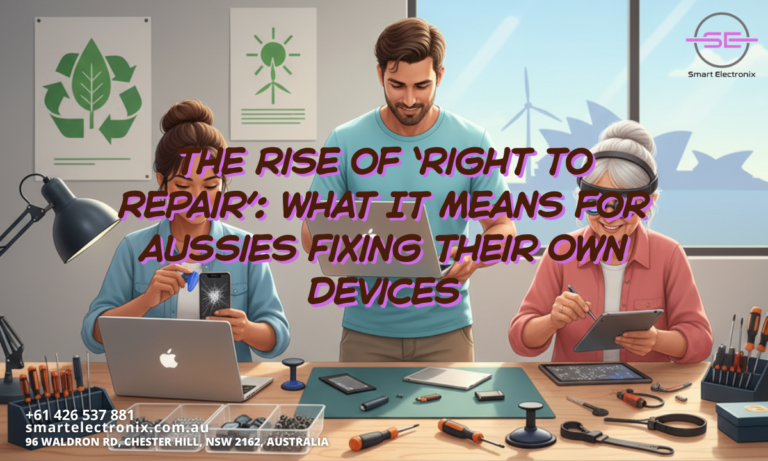
When was the last time you cracked your phone screen or had your laptop battery suddenly give up on you? For most Aussies, the first instinct is to rush to the nearest repair shop or buy a replacement device. But in 2025, things are shifting. The global “Right to Repair” movement is gaining momentum, and it’s not just about saving money – it’s about empowering consumers, reducing e-waste, and making technology more sustainable. At Smart Electronix, we’re keeping a close eye on how this movement is reshaping the repair industry and what it means for Australians who want more control over their gadgets.
What Exactly Is the Right to Repair?
The Right to Repair is a consumer-focused movement that advocates for laws and policies requiring manufacturers to make spare parts, repair manuals, and diagnostic tools accessible to everyone. In simple terms, it gives users the legal right to fix their devices rather than being forced to rely only on the manufacturer or replace the gadget altogether.
Why Is It Important in Australia?
Australia, like many other countries, has been battling with growing electronic waste. Each year, thousands of phones, tablets, and laptops end up in landfills simply because people either can’t find affordable repair services or manufacturers refuse to make repair resources available. By supporting the Right to Repair, Aussies gain the freedom to:
- Extend the life of their devices
- Save money on unnecessary replacements
- Contribute to a greener, more sustainable environment
The Benefits for Everyday Users
For students, professionals, and businesses alike, the Right to Repair brings multiple advantages:
- Affordability – Repairs become cheaper as third-party shops and individuals gain access to the necessary tools and parts.
- Convenience – No more long waits for official service centers. Local shops can provide faster, more accessible solutions.
- Sustainability – Repairing devices instead of replacing them reduces environmental impact.
- Empowerment – Aussies can choose how and where to repair their devices without being tied to one company’s policies.
How Manufacturers Are Reacting
Not all manufacturers are thrilled about this change. Many companies profit from expensive repairs or device upgrades, so opening the door to independent repairs challenges their business models. However, global awareness and consumer demand are pushing companies to comply. Some brands have even started selling repair kits and publishing repair manuals to meet growing expectations.
Smart Electronics and the Repair Future
At Smart Electronix, we believe in empowering Australians by offering affordable, high-quality repair services. Our team stays updated with the latest tools and techniques so you don’t have to throw away your device at the first sign of trouble. We also support the movement by encouraging awareness and helping customers make informed choices about their technology.
The Challenges Ahead
While the Right to Repair has clear benefits, challenges remain:
- Some manufacturers still restrict access to key components.
- Repair costs can remain high if parts aren’t widely available.
- New technologies like foldable screens and biometric sensors require advanced skills for safe repair.
Despite these obstacles, the movement is growing stronger, and more countries, including Australia, are considering policies that make repairs easier and more accessible.
What Aussies Can Do Now
If you’re in Australia and want to take advantage of the Right to Repair, here are a few steps:
- Choose repair-friendly brands that offer replacement parts.
- Support local repair shops instead of replacing devices immediately.
- Stay informed about upcoming legislation in Australia.
- Recycle responsibly if your device truly can’t be fixed.
Final Thoughts
The rise of the Right to Repair is more than just a consumer rights issue – it’s about sustainability, affordability, and freedom of choice. For Australians, this means a future where fixing a cracked phone screen or replacing a laptop battery doesn’t have to cost a fortune or create unnecessary waste. With companies like Smart Electronix supporting this shift, Aussies are better equipped than ever to take control of their devices.
So next time your gadget acts up, remember: replacing it isn’t your only option. The Right to Repair is here to give you smarter, greener, and more affordable choices.
